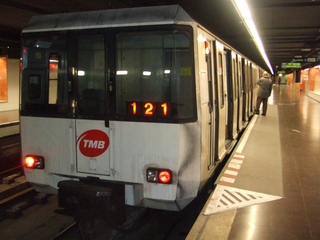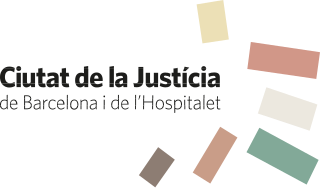
Line 1, shortened to L1, coloured red and often simply called Línia vermella, is the second oldest Barcelona Metro line, after line L3. It is the longest line of the Barcelona Metro, and links L'Hospitalet de Llobregat and Santa Coloma de Gramenet. Originally operated by the independent Ferrocarril Metropolitano Transversal de Barcelona, it is today operated by Transports Metropolitans de Barcelona (TMB) and is part of the ATM fare-integrated main transport system. L1 is the only metro line in Spain to use Iberian gauge tracks, as used by most Spanish main line railways.

Line 9 is a completely automated line of the Barcelona Metro network that is currently under construction, with 24 stations open in Barcelona and El Prat de Llobregat, L'Hospitalet de Llobregat, Badalona and Santa Coloma de Gramenet suburbs, since December 2009. The line is currently disconnected in two branches, with a connecting part between the two yet to be built. The Aeroport T1 – Zona Universitària section is called L9 South, and the La Sagrera – Can Zam portion L9 North. Upon completion, it will be the longest underground metro line in Europe.
— Line 8, coloured pink and operated by FGC, is part of the Barcelona Metro network, and therefore of the larger ATM fare-integrated transport system. It joins Plaça Espanya, in the Sants-Montjuïc district of Barcelona with metropolitan area municipalities of L'Hospitalet de Llobregat, Cornellà de Llobregat and Sant Boi de Llobregat.

Hospital de Bellvitge, formerly known as Feixa Llarga, is a Barcelona Metro station, in the L'Hospitalet de Llobregat municipality of the Barcelona metropolitan area, and named after the nearby Bellvitge University Hospital. The station is the western terminus of line L1.

Gornal is a railway station on the Llobregat–Anoia Line. It is located in the neighborhood of the same name, in the L'Hospitalet de Llobregat municipality, to the south-west of Barcelona, in Catalonia, Spain. It was opened in 1987, when the line's section between Ildefons Cerdà and Sant Josep stations was put underground. It is served by Barcelona Metro line 8, Baix Llobregat Metro lines S33, S4 and S8, and commuter rail lines R5, R6, R50 and R60.

Ildefons Cerdà is a railway station on the Llobregat–Anoia Line. It is not properly located in Plaça d'Ildefons Cerdà, but in the L'Hospitalet de Llobregat municipality, in Catalonia, Spain. The station is situated underneath Gran Via de les Corts Catalanes and was opened in 1987. It is served by Barcelona Metro line 8, Baix Llobregat Metro lines S3, S4 and S8, S9, and commuter rail lines R5, R6, R50 and R60.

Can Boixeres is a station on line 5 of the Barcelona Metro.

Can Vidalet is a station on line 5 of the Barcelona Metro.

Collblanc is a station on line 5, line 9 and line 10 of the Barcelona Metro.
Europa | Fira is a railway and metro station on the Llobregat–Anoia Line. It is located underneath Gran Via de les Corts Catalanes, near Plaça d'Europa and Carrer d'Amadeu Torner, in the L'Hospitalet de Llobregat municipality, to the south-west of Barcelona, in Catalonia, Spain. Opened on 13 May 2007, it was due to be named Amadeu Torner, in reference to the street of the same name. The station can be accessed from both sidewalks of Gran Via, serving as a major public transport access to the Gran Via business center. It is served by Line 8, Line 9, Baix Llobregat Metro lines S33, S4 and S8, and commuter rail lines R5, R6, R50 and R60.

Bellvitge | Rambla Marina is a Barcelona Metro station, in the L'Hospitalet de Llobregat municipality of the Barcelona metropolitan area, and named after the nearby neighbourhood of Bellvitge. The station is served by line L1. It is some 750 metres (2,460 ft) west of Bellvitge railway station, served by Rodalies de Catalunya commuter and regional rail services.

Plaça d'Ildefons Cerdà is a square in Barcelona, part of La Bordeta, in the Sants-Montjuïc district, very close to the boundary of the municipality of L'Hospitalet de Llobregat. It is named after the city's renowned urban planner Ildefons Cerdà. It is essentially a large roundabout which connects different parts of the city. The new courts of Barcelona and L'Hospitalet de Llobregat, collectively known under the name Ciutat de la Justícia are located in the immediacy of this square. Recent redevelopment has changed the area's feel, as well as promotion of the different Fira de Barcelona venues, not far from the square. Decisions made by recent urbanists has been criticised as a place hostile to strollers and therefore quite different from the idea of Barcelona an urbanist like Ildefons Cerdà had. A monument to Cerdà by sculptor Antoni Riera Clavillé was inaugurated in 1959, one century after his original urban plan, but was removed shortly after General Jorge Vigón, the Francoist Minister of Public Works, dismissed it publicly. There is no name plate in the square, which makes it theoretically a nameless space.

Can Serra is a Barcelona Metro station, in the L'Hospitalet de Llobregat municipality of the Barcelona metropolitan area, and named after the nearby Can Serra neighbourhood. The station is served by line L1.
Rambla Just Oliveras is a Barcelona Metro station, in the L'Hospitalet de Llobregat municipality of the Barcelona metropolitan area, and named after the nearby street of Rambla Just Oliveras. The station is served by line L1, and is adjacent to the L'Hospitalet de Llobregat railway station, the main Rodalies Barcelona and mid-distance transport hub in the area.

La Maternitat i Sant Ramon is a neighborhood in the les Corts district of Barcelona, Catalonia (Spain), the westernmost area of the district, distinctly more working class than its neighbours Pedralbes and Les Corts and similar to the also neighbouring L'Hospitalet de Llobregat and Sants. It was part of the former independent municipality of Les Corts, also known as les Corts de Sarrià. Its name stems from the 19th century maternity house known as La Maternitat, in Travessera de Les Corts, designed by Camil Oliveres i Gensana and which includes a large garden. It's made up of residential areas to the west such as Sant Ramon proper and the Torre Melina buildings, and the build-up areas of La Maternitat and Can Bacardí to the east. Centre Cívic Riera Blanca is this neighbourhood's community centre.

Ernest Lluch is a Trambaix tram stop and a Barcelona Metro station in L'Hospitalet de Llobregat, to the south-west of Barcelona. The construction works of the new station started in 2007, though they were suspended in 2011 by the Catalan government due to the 2008–15 financial crisis in the country, construction was reactivated in 2019 and inaugurated on July 25, 2021. The metro station is located between the Pubilla Cases and Collblanc stations, and serves as an interchange station to the Trambaix tram system. The station was initially intended to be named Cardenal Reig, a street in the area, or Sant Ramon, the former name of the Trambaix stop.
Sant Josep is a railway station on the Llobregat–Anoia Line. It is located underneath Avinguda Carrilet, between Carrer de Miquel Romeu and Carrer de Mestre Candi, in the L'Hospitalet de Llobregat municipality, to the south-west of Barcelona, in Catalonia, Spain. The current underground station was opened on 8 July 1985, replacing the original at-grade station dating of 1912. It is served by Barcelona Metro line 8, Baix Llobregat Metro lines S33, S4 and S8, and commuter rail lines R5, R6, R50 and R60.

The Ciutat de la Justícia de Barcelona i l'Hospitalet de Llobregat or just Ciutat de la Justícia is a recent architectural development in the Sants-Montjuïc district of Barcelona and its immediately adjacent suburb of l'Hospitalet de Llobregat, on Gran Via de les Corts Catalanes near Plaça d'Ildefons Cerdà and Plaça d'Europa. It hosts most of the legal departments of the metropolitan area, which were previously located in 17 separate buildings scattered around both cities. It does not include the whole of Barcelona's judicial administration, but shares it with the Palace of Justice of Barcelona, on Passeig de Lluís Companys. The 330,000 square metres it spans are distributed in eight buildings designed by David Chipperfield Architects and Fermín Vázquez. It was envisioned as part of the urban regeneration program for L'Hospitalet de Llobregat that has taken place over the decades of the 2000s and 2010s.

Plaça d'Europa is a square in the District VII of L'Hospitalet de Llobregat suburb of Barcelona, Catalonia in Spain. Located on the Granvia de l'Hospitalet avenue at the intersection with Carrer d'Amadeu Torner. It is part of L'Hospitalet's recent urban development, and one of its biggest squares at 33 ha, with a distinguishable skyline made up of high-rises, among the tallest structures in the city, some of which are designed by the renowned architect Toyo Ito. It is expected to become its economic centre, and will allow different parts of the city formerly severed by the Granvia to become interconnected. It is still not completed but already featuring most of its planned buildings and infrastructure. Part of Fira de Barcelona, near it stand the pavilions of rest of Fira de Barcelona and the shopping centre Gran Via 2.

The Estadi Municipal de Futbol de L'Hospitalet is a football stadium located in the Feixa Llarga district of L'Hospitalet de Llobregat, Catalonia, Spain. It was opened in 1999. It has a capacity of 6740 seated spectators. Currently it is the home of football club CE L'Hospitalet. The stadium is some 700 metres (2,300 ft) from the Hospital de Bellvitge metro station, on line L1 of the Barcelona Metro.

















